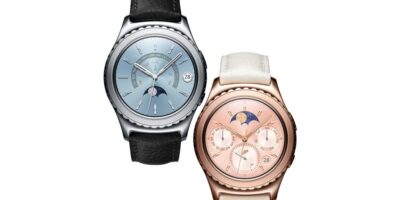Add security for BYOD to really take off
Employees need to be connected and communicate via a multitude of device and many companies have created BYOD (bring your own device) use policies. Caroline Hayes finds out what this will mean for smartwatches.
A report by ABI Research (Enterprise Wearable Device Market Overview: Watches) forecasts enterprise smartwatch shipments will increase from just two million in 2017 to reach nearly 14million in 2022. To be effective and widely used in the workplace, though, security management and compliance must be addressed at the design level.
I asked Stephanie Lawrence, research analyst at ABI Research how enterprises might adopt the corporate-wide use of smartwatches, without compromising security.
“Smartwatches have a number of different use cases within the enterprise,” she says, “such as providing a real- time information and notification interface, for example, in a hospital medical staff can be alerted to changes in a patient’s condition; monitoring fatigue, falls, and health as some smartwatches have sensors such as accelerometers, gyroscopes, barometers, and altimeters, allowing them to detect falls, fatigue, health metrics, and environmental conditions; and tracking remote workers’ location, as many smartwatches have embedded GPS and Wi-Fi,” she adds.
There is a downside, in that few smartwatches (and wearables in general) have enterprise-grade authentication integrated, making them vulnerable to security breaches, and risking sensitive data being wrongfully accessed. To address security, companies can chose enterprise mobility management (EMM), together with mobile app management (MAM), and mobile device management (MDM); all options that enable enterprises to automate the connectivity and management of devices on the corporate network.
“Some smartwatch manufacturers, such as Samsung, offer their own EMM solutions,” confirms Lawrence. “These focus on managing the devices by giving the company security tools, such as remote screen locking and the ability to set password rules, deactivate certain functions, and deploy secure systems. This helps to ensure that each device only has access to the information that it requires, and in the case of the device being lost or stolen, it can be wiped and locked remotely. A number of software companies also provide these EMM solutions and other platforms for controlling the devices, such as Kony, Total Communicator Solutions, and Upskill”.
In San Diego Airport, staff wear Samsung Gear S3 and S2 watches for bi-directional communication. They can communicate IT issues, such as flight information display boards not updating,” explains Lawrence. “For example,” she says “an employee can alert IT staff members via his or her smartwatch to an issue, and thanks to beacon technology, the nearest IT employee receives the alert and can respond quickly. When the issue is resolved, the IT employee updates the central database using his or her smartwatch”.
I wondered what a smartwatch can bring that any other internal communication system could not. “Smartwatches have a number of advantages over smartphones and PDAs. In a noisy environment, if a worker receives a notification on their smartphone, it is likely that they won’t hear/feel it, as it is most often kept in a pocket,” says Lawrence. “A smartwatch is always connected to the worker’s wrist, so they will easily feel when a notification comes in. Smartwatches also help to prevent accidents, as they can easily monitor the worker’s vital signs and environmental conditions, ensuring that they are alerted to any issues immediately. They also prevent workers from needing to take out a separate device to have access to information, which means they can continue to concentrate on their work. This improves efficiency and prevents accidents, especially in dangerous working conditions”.
To implement a similar system, many companies will adopt a BYOD policy. The advantages to that, points out Lawrence, are that it can save the company a lot of start-up cost, and ensures that staff are comfortable with the devices. Companies providing employees with smartwatches will do so for a number of reasons. “Securing the data that smartwatches have access to is easier with corporately provided devices,” points out Lawrence, “enabling IT teams to remotely wipe data and lock the devices if lost or stolen”. Another major advantage is employee participation, as devices bought privately will need to be updated, which can represent a large sum of money, which not all employees will be able or willing to spend. “If the company provides the devices, it ensures that all necessary employees have access to them, preventing the disjointed adoption throughout the company,” says Lawrence.
PIC CAPTION
Samsung Gear 2 (pictured) and Samsung Gear 3 smartwatches are in use by staff at San Diego International Airport, California, for staff communication around the site.
WEARTECHDESIGN.COM – Latest News/Advice on Technology for Wearable Devices
Weartechdesign is unlike any other website currently serving the technology
for wearable devices. We carry the very latest news for design engineers and purchasers.
Register on our mailing list to receive regular updates and offers from
WearTechDesign




